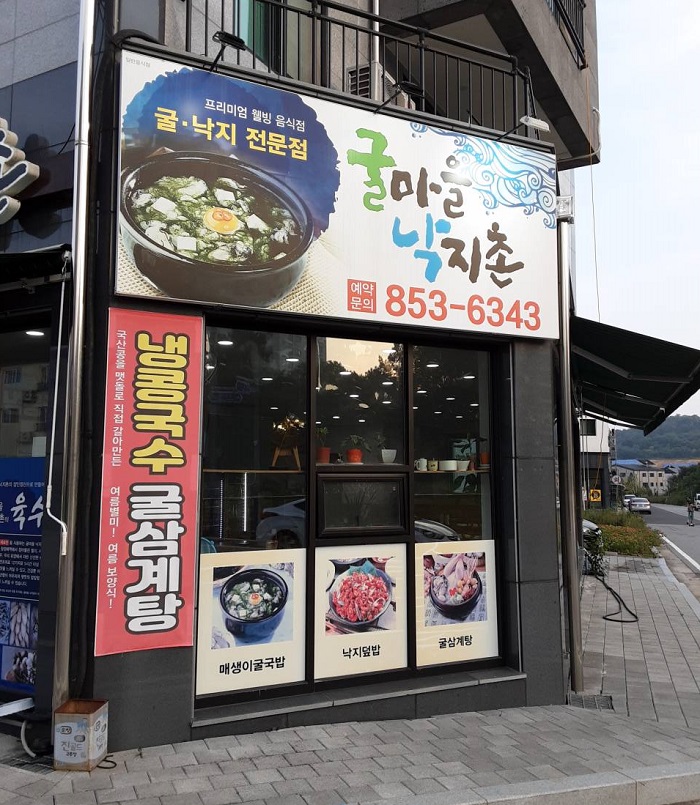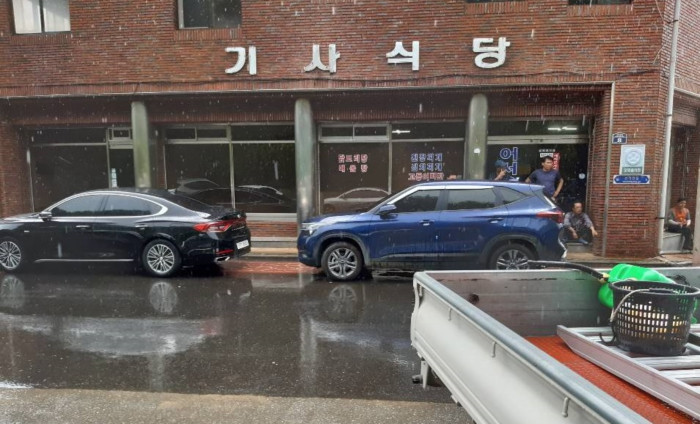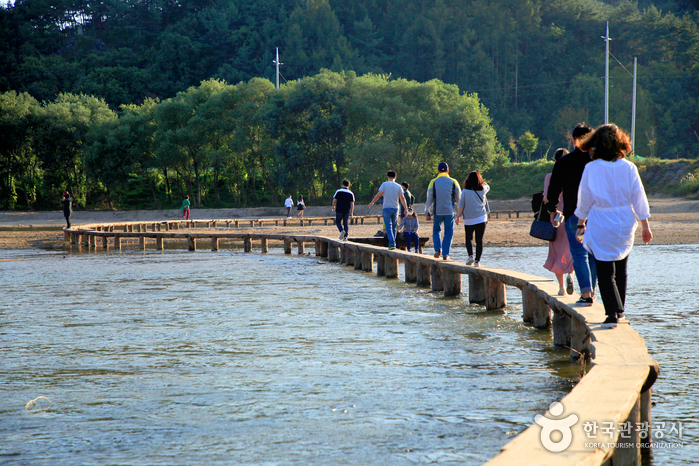Gulmaeul Nakjichon (굴마을낙지촌)
18.0Km 53 2021-03-24
26, Pungyo, 3-gil, Andong-si, Gyeongsangbuk-do
+82-54-853-6343
It is a place where you can eat various seafood dishes and soup. The best menu at this restaurant is oyster and rice soup. This Korean dishes restaurant is located in Andong-si, Gyeongsangbuk-do.
Aldea Yekki (예끼마을)
18.1Km 0 2024-05-17
Seonseong-gil 14, Dosan-myeon, Andong-si, Gyeongsangbuk-do
La Aldea Yekki está llena de callejones con coloridos murales, galerías con obras de arte de artistas locales y un centro de experiencia de casa tradicional hanok. Una actividad particularmente popular es un paseo por el Sendero Seonseongsusang-gil, que cruza el lago y ofrece hermosos paisajes.
Sendero Seonseongsusang-gil (선성수상길)
18.1Km 0 2024-05-17
Seonseong-gil 14, Dosan-myeon, Andong-si, Gyeongsangbuk-do
Jeongjae Head House [Korea Quality] / 정재종택 [한국관광 품질인증]
19.2Km 7775 2023-04-13
경상북도 안동시 임동면 경동로 2661-8
+82-10-8590-0625
Boasting more than 300 years of tradition, Jeongjae Traditional House is the head house of Ryu Chi-myeong (pen-name: Jeongjae), who inherited the study of Togye Yi Hwang (1501-1570), one of the two most prominent Korean Confucian scholars of Joseon. The old house features the characteristic construction elements of a Joseon hanok, including the stylobate, wooden pillars, toenmaru (the narrow wooden porch running along the outside of the building), tiled roof, and other structures, and commands an open view of Imha Lake. The house was originally built by Ryu Gwan-hyeon, the great-great-grandfather of Ryu Chi-myeong, in 1735 (the 11th year of the reign of King Yeongjo of Joseon) in the village of Handeul in Imdong-myeon, Andong-si, Gyeongsangbuk-do, but it was relocated to the foot of Guamsan Mountain in 1987 when Imha Dam was built and the surrounding area was submerged as a result. The house consists of the daemunchae (gate building), jeongchim (a ‘ㅁ’-shaped house with a tiled roof), haengnangchae (servants’ quarters), a shrine, and a pavilion. The sarangchae (men’s quarters) is clearly visible, while the anchae (women’s quarters) is concealed within the house. The sarangchae has a sarangmaru (wooden floor), a large sarangbang room, a small sarangbang room, and there is a small maru between the two rooms. The buildings of the sarangchae and anchae are clearly divided into segregated spaces for men and women according to Confucian tradition. The anchae has a daecheongmaru (large wooden floor) in the middle; a main room, kitchen, and toilet on the right; and a numaru (upper floor) and sangbang (upper room) on the left. The small side door of the main gate links to the door by which to enter the anchae, which has a small vegetable garden. Manujeong Pavilion (Gyeongsangbuk-do Cultural Heritage Material No. 37) is a half-hipped roof building with single-layered eaves located on the left side of the house outside the main gate. It is the place where Ryu Chi-myeong used to teach his students, and consists of a large maru and a guest room. The pavilion is also surrounded by the beautiful scenery of Imha Lake, mountains, and chestnut trees. Jeongjae Traditional House provides two special experience programs: Making Songhwaju, which is the Ryu family’s home-brewed liquor (15 to 18 degrees) made with rice, glutinous rice, yeast, pine needles, and chrysanthemums, led by the owner’s wife (Intangible Cultural Asset No. 20); and Making Tarak, which is a fermented milk drink that has been made by the Ryu’s family for some 500 years. As the recipe for making Tarak is relatively simple, and uses yeast that is usually used to make raw rice wine like Makgeolli, people can easily make it at home. The house also runs a traditional music program designed to show participants how to play the gayageum (Korean zither with twelve strings) and sing Korean folk songs, and stages small concerts.
Imhaho Gisa Sikdang(임하호기사님식당)
19.6Km 194 2021-04-09
8, Seonchakjang-gil, Andong-si, Gyeongsangbuk-do
+82-54-822-4929
There are a variety of side dishes, so you can enjoy different foods. This Korean dishes restaurant is located in Andong-si, Gyeongsangbuk-do. The representative menu is kimchi stew.
Aldea Museom de Yeongju (영주 무섬마을)
19.8Km 4930 2021-05-07
Museom-ro 234-beongil 31-12, Munsu-myeon, Yeongju-si, Gyeongsangbuk-do.
+82-54-638-1127
La Aldea Museom de la ciudad de Yeongju es una de las principales aldeas tradicionales de Corea que tienen tres lados rodeados por un río (Aldea Hahoe de Andong, Aldea Seonam de Yeongwol, Hoeryongpo de Yecheon, etc).
La unión de los arroyos Naeseongcheon y Yeongjucheon fluye velozmente por las faldas de los montes Taebaeksan y Sobaeksan; y abraza la aldea haciéndola parecer como una isla sobre tierra. El blanco arenal extendido por todo el río y los frondosos bosques crean fantásticas vistas naturales, y se estima que fue a mediados del siglo XVII cuando la gente empezó a poblar el sitio. La familia Park de Bannam y la familia Kim de Yean son las más predominantes, y en la actualidad se encuentran 48 familias que viven manteniendo las tradiciones.
Nueve casas hanok de esta aldea están registradas como Patrimonio Cultural de Gyeongsangbuk-do. Entre las que más destacadas están Haeudang y Manjukjae. Haeudang, Patrimonio Folclórico de Gyeongsangbuk-do Nº 92, se localiza a la izquierda tras cruzar el puente Sudogyo. La vivienda lleva el nombre poético de su primer dueño Kim Nak-pung. Otro tesoro para visitar sin falta es Manjukjae, una de las casas hanok más viejas de la zona. En el centro está Manungotaek, una edificación del siglo XIX y Tesoro Folclórico Nº 118. Esta es la casa de la familia de la mujer del poeta de renombre Jo Ji-hun, quien a través del poema Byeolli exaltó la belleza natural de la Aldea Museom.
La atracción que complementa el turismo en la Aldea Museom es el puente de árbol que sirvió de conexión entre la aldea y la otra orilla del río durante 350 años. El puente mide aproximadamente 150 metros, aunque su ancho mide apenas 30 cm. Ahora, con la construcción del Puente Sudogyo que es más moderno y seguro, el puente de árbol ha perdido su función, pero cada año los habitantes de la zona organizan diferentes celebraciones para revivir el pasado.
Dojeong[Korea Quality] / 도정서원 [한국관광 품질인증]
19.8Km 318 2020-12-10
417, Gangbyeon-ro, Homyeong-myeon, Yecheon-gun, Gyeongsangbuk-do
+82-10-3451-9900
Dojeongseowon Confucian Academy (142th Cultural Heritage Material of North Gyeongsang Province), located in Yecheon, North Gyeongsang Province, has been reborn as a unique Hanok stay destination. Originally established to commemorate Yakpo Jeong Tak (1526-1605), a man who saved the life of Admiral Yi Sunsin during his imprisonment, Dojeongseowon is located on the middle of a mountain surrounded by Naeseongcheon Stream. There are 4 rooms in total, namely the Lecture Hall, Euphojeong Pavilion, and Dongjae and Seojae dormitories. The Lecture Hall building is built upon a stone pedestal and has an expansive hall with a great view over the Naeseongcheon Stream. Breathing in the clear air of Yecheon brings one back to the days when the lecture hall rang out with the discussions of the scholars. With a floor area of about 100㎡, there are three rooms in total, making the unit an optimal choice for workshops and other group trips. The most exclusive and beautiful room is the Euphojeong Pavilion, built upon a cliff overlooking the Naeseongcheon Stream. It was the place reserved for guests of the academy, and it is also the best place in the complex to hear the sounds of water rushing down the stream below the cliff. Dongjae and Seojae units include a bathroom, but guests staying in the Euphojeong Pavilion and the Lecture Hall must use a public bathroom outside the building. Ipdeokru Pavilion, which functioned as something akin to the gate to the entire complex, is a seminar room which can host up to 30 people. Standing on the 2nd floor of the pavilion brings one to the view of the Naeseongcheon Stream flowing in an arc around the mountain. Outdoor barbecue grills are located to the back of the Dongjae and Seojae units.
Yecheon is a city brimming with scenic sights and historic heritages. Choganjeong Pavilion, the filming site of the K-drama Mr. Sunshine, is located 30 minutes away by car. Other sights like Hoeryongpo Meandering Stream, Geumdangsil Traditional Village, and Yongmunsa Temple are located 30 minutes by car.
Suaedang [Korea Quality] / 안동 수애당 [한국관광 품질인증]
19.9Km 71641 2023-04-13
1714-11, Sugogyonggye-ro Imdong-myeon, Andong-si, Gyeongsangbuk-do
+82-54-822-6661
'Suaedang Traditional House was built by Ryu Jin-geol, also known by his pen-name of Suae, in 1939. This hanok-style house consists of three buildings that measure 29-kan (a traditional measurement that corresponds to the space between two columns) in total.
The main room, or jeongchim (7-kan at front and 2-kan at sides), has a half-hipped roof, and forms a‘ㄱ’-shape with the storeroom (10-kan at front), which also has a half-hipped roof. Originally located at 612 Sugok-dong, Andong-si, the house was relocated from a slight slope to a flat piece of land due to the construction of Imha Dam in 1987. Consequently, the Jeongchim was rebuilt at a lower level than before.
The Suaedang was renovated by modernizing the old-style facilities including the kitchen, toilets, and washroom without changing their external features, while the rooms and daecheongmaru (main floored room) were decorated with red clay and natural paint. Suaedang, with its beautiful panoramic view of the lake, was designated as Gyeongsangbuk-do Cultural Property No. 56.


![Jeongjae Head House [Korea Quality] / 정재종택 [한국관광 품질인증]](http://tong.visitkorea.or.kr/cms/resource/96/2579496_image2_1.jpg)


![Dojeong[Korea Quality] / 도정서원 [한국관광 품질인증]](http://tong.visitkorea.or.kr/cms/resource/92/2636192_image2_1.jpg)
![Suaedang [Korea Quality] / 안동 수애당 [한국관광 품질인증]](http://tong.visitkorea.or.kr/cms/resource/88/2528888_image2_1.jpg)
 Español
Español
 한국어
한국어 English
English 日本語
日本語 中文(简体)
中文(简体) Deutsch
Deutsch Français
Français Русский
Русский